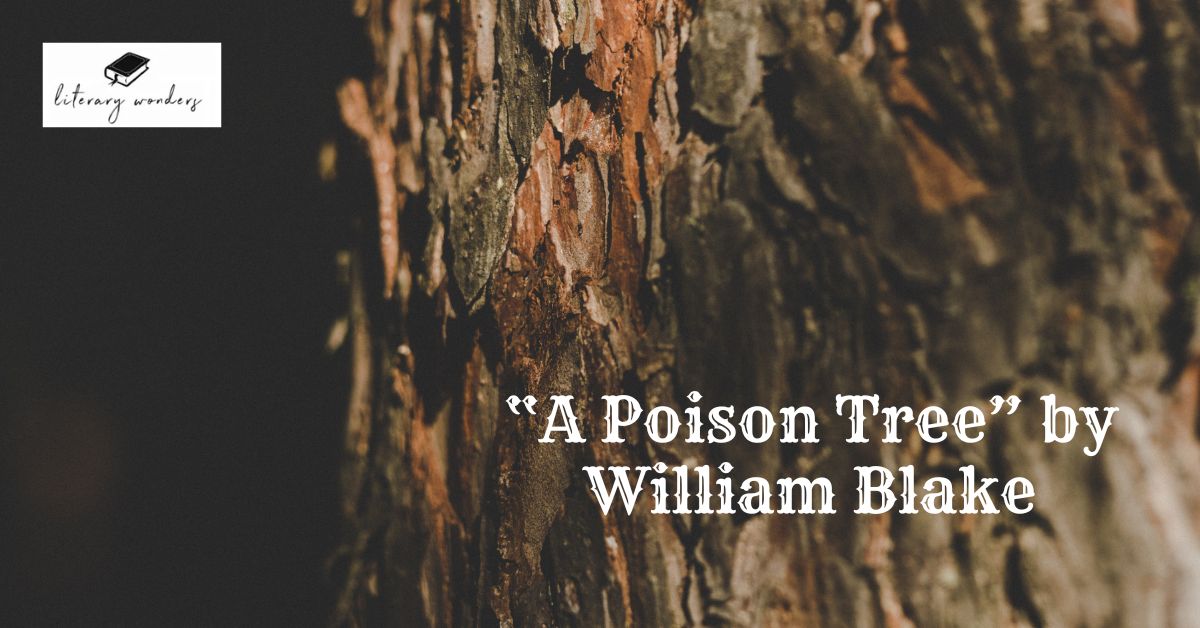“A Poison Tree” by William Blake – Introduction
“A Poison Tree” by William Blake, a famous American poet, and writer, is a descriptive poem. This illustrative poetic piece was first appeared in his work, Songs of Experience, in 1974. It sheds light on key human emotion, anger, and its destructive impacts on humanity. It also elucidates that anger becomes poisonous if it is not expressed at the right time. The poem brilliantly illustrates the duality of human nature by describing two different events on which he expressed his anger distinctly. He says that his anger with his friend dissipated as soon as the situation became normal. However, his unexpressed anger with his foe grew and morphed into something poisonous. Moreover, he nurtured and watered this anger with resentments, fake smiles, and fear. Consequently, it grew and harmed his foe. Ironically, the harm it caused to the speaker’s enemy brought him immense pleasure.
Major Themes in “A Poison Tree”
The evil nature of mankind, negative human emotions, and destructive impacts of anger are the major themes of the poem, “A Poison Tree”. This simple yet meaningful poem illustrates the catastrophic impacts of unexpressed anger. The poet brilliantly delves into our minds and explains the harm that anger brings to the heart where this strong emotion nourishes. However, the same outrage seems less damaging when someone gets offended by friends. The reason being, we love to express our good as well as destructive emotions to our friends. However, we hesitate to be true to our foes; we do not represent ourselves fully. In this case, the speaker faces the same situation. He expresses his anger to his friend and gets relaxes. However, his unexpressed anger makes him revengeful. The constant hiding of rage he has for his foe brings an irreparable loss to his enemy.
Analysis of Literary and Poetic Devices Used in “A Poison Tree”
To bring depth, clarity, and richness in the poem, the writer has artistically inserted some literary and poetic devices in the poem such as;
- Allusion
- Antithesis
- Imagery
- Metaphor
- Symbolism
The first literary device that seems dominant is Allusion. Allusion refers to the indirect and brief reference of a place, person, or thing important in a historical or religious context. In this poem, “an apple,” “tree,” and “garden” allude to Adam, Eve, and the Garden of Eden. The second significant device that appeared in the poem is the antithesis. It is a figure of speech that refers to the juxtaposition of contrasting ideas. The writer has posed two opposing ideas related to anger. To captivate and lure the audience, the writer has used vivid and persuasive imagery in the poem.
By using powerful diction, the writer has successfully created certain images, showing the destructive impacts of anger. Offering a phenomenal explanation of specific emotions and ideas, William Blake has inserted various metaphors in the poem. The apple is the metaphor of the forbidden fruit, and the garden metaphorically stands for the Garden of Eden. Similarly, to bring harmony in the text, the poet has divided this poem into four-lined stanzas, called a quatrain. Moreover, he has used end rhyme in the poem to bring a lyrical quality in the poem such as; “friend/end,” “foe/grow,” and “see/tree.”
In-depth Analysis of “A Poison Tree” by William Blake
Stanza #1
The opening stanza of the poem explains two different approaches to anger. The speaker explains once he was angry with his friend, he told his friend about his concerns, which subsequently disappeared. However, he did not express his anger to his friend, and this holding on provided a fertile ground for the anger to nurture and grow.
Stanza#2
This stanza highlights how he looked after the unexpressed anger. Ironically, the speaker cultivated this anger as if it is a plant. He adds, he watered this negative trait with fears and tears continuously. Moreover, his fake smiles and gentle deception further aided his anger for his foe.
Stanza#3
This stanza further highlights the damages that anger caused to the speaker. Instead of expressing his hatred, the speaker continued to grow this metaphorical tree of hatred until one day it bore an attractive fruit. His enemy saw this catchy fruit and knew that it belonged to the speaker. However, his enemy failed to read the veiled emotions of the speaker that he grew this fruit just to trap him.
Stanza#4
”The final stanza captures the extreme level of hatred. Using tactile imagery, the speaker explains how his enemy sneaks into his garden at night, unaware of the dangers that awaited him. The next morning, the most awaited moment arrives when the speaker sees his enemy dead under the same tree.
Conclusion
“A Poison Tree” by William Blake presents a precise yet powerful argument against the suppression of anger. By talking about the dark side of human emotion, the speaker illustrates how suppression of anger made people stand on the verge of violence and destruction. To support his argument, he presents two contrasting scenarios, describing the damage of suppressing anger.
See Also:
Based on the Descriptions What Rhyme Scheme Does the Poem “Harlem” Use?

